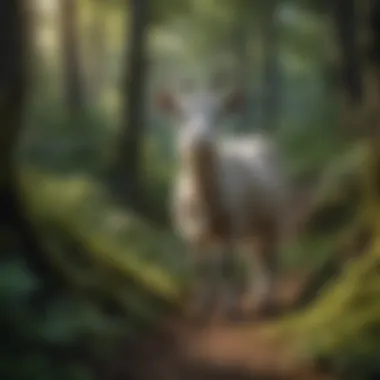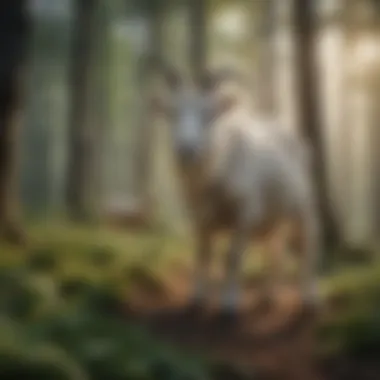Exploring the Gray Goat South: Insights on Ecology and Culture


Intro
The Gray Goat South region presents a complex mosaic of forest ecosystems intertwined with agricultural practices, particularly involving goats. This intricate relationship bears significant implications for both the environment and local communities. In this article, we will examine the central themes of ecological integrity, cultural relevancy, and effective management strategies. Our objective is to provide a nuanced perspective that illuminates the multifaceted nature of this unique region.
Understanding Woodland Ecosystems
Importance of Biodiversity in Forests
Biodiversity serves as the backbone of forest ecosystems. High levels of biodiversity contribute to the resilience of these environments, enabling them to withstand various stressors such as climate change and invasive species. The Gray Goat South is home to a diverse array of flora and fauna, each playing a role in maintaining ecosystem balance. Understanding the relationships among species is essential for preserving the health of these woods.
Moreover, diverse species can offer essential services that enhance forest health. For example, certain plants may improve soil stability, whereas others enhance nutrient cycling. Protecting this biodiversity is crucial for ensuring that the forest can sustain its ecological functions over time.
Role of Forests in Climate Regulation
Forests play a vital role in regulating the climate. Through the process of photosynthesis, trees absorb carbon dioxide and release oxygen, acting as carbon sinks. In the context of the Gray Goat South, the preservation of these forests not only supports local wildlife but also has broader implications for global climate stability. A healthy forest can mitigate local temperature variations, maintain moisture levels, and even influence weather patterns.
"Preserving forests can significantly impact climate change mitigation efforts, enhancing both environmental health and community well-being."
By maintaining these wooded areas, communities can simultaneously address issues of local biodiversity conservation while contributing to global climate action.
Sustainable Forestry Practices
Principles of Sustainable Forestry
Sustainable forestry hinges on several core principles aimed at meeting current needs without compromising future generations. These include:
- Maintaining forest health and productivity.
- Protecting biodiversity by ensuring that ecosystems remain diverse and resilient.
- Involving local communities in decision-making processes, enhancing engagement and stewardship.
- Implementing practices that minimize environmental impact while allowing for effective wood production.
The Gray Goat South has a unique opportunity to embrace these principles through goat-related forestry practices. Utilizing goats for underbrush management not only aids in controlling invasive species but also contributes to sustainable land management practices.
Case Studies of Successful Implementations
Examining successful implementations of sustainable forestry practices can provide valuable insights. For instance, certain community-led initiatives in the Gray Goat South have demonstrated effective use of goats for forest maintenance, particularly in controlling vegetation and enhancing soil health. Communities that have integrated goats into their forest management systems report improvements in biodiversity and productivity.
Woodland Stewardship Techniques
Forest Management Plans
Developing effective forest management plans is essential for sustaining woodland resources. These plans should provide clear guidelines on how to balance logging activities with conservation needs. In the Gray Goat South, local stakeholders can collaboratively create management plans that include:
- Setting aside conservation areas to protect critical habitats.
- Implementing regulated logging practices that maintain overall forest health.
- Continuous monitoring of ecological impacts resulting from both forestry and agricultural practices.
Conservation Strategies
Conservation strategies in the Gray Goat South must consider both ecological and cultural dimensions. Some effective strategies might include:
- Restoration of native species to enhance biodiversity.
- Establishment of educational programs to increase community awareness about forest conservation.
- Collaborating with regional organizations to share resources and expertise in sustainable land use practices.
By embracing these strategies, the Gray Goat South has the potential to serve as a model for other regions navigating the balance between agriculture and environmental stewardship.
Foreword to the Gray Goat South
The Gray Goat South represents a unique intersection of ecological richness and cultural heritage. This article will explore various elements that underscore the importance of understanding this region. Recognizing its significance is not merely an academic pursuit; it has direct implications for sustainable forestry management and biodiversity conservation.
Geographical Overview
The geographical layout of the Gray Goat South is characterized by its diverse ecosystems. It spans several states, each contributing to a rich tapestry of habitats ranging from dense forests to open grasslands. This region is mostly located in the southern United States, showcasing a mixture of temperate and subtropical climates. Key rivers and streams weave through its terrain, promoting a variety of flora and fauna.


Key Features:
- Elevation Variability: The region features varied elevations that influence local weather patterns and biodiversity.
- Soil Diversity: Soil types in the area range from clay to sandy loams, affecting agricultural practices and vegetation types.
- Microclimates: Localized weather patterns create microclimates conducive to specific plant and animal species.
These geographical characteristics play an essential role in shaping the ecological landscape of the Gray Goat South, influencing both the habitats and the organisms that thrive within them.
Significance of the Gray Goat
The Gray Goat holds substantial significance both ecologically and culturally. One key aspect lies in its contribution to sustainable land management practices. The use of goats in forestry helps in invasive species control and forest undergrowth management, promoting healthier ecosystems. This practice not only enhances biodiversity but also supports soil health and nutrient cycling.
Moreover, the cultural traditions surrounding goat farming are deeply rooted in the communities throughout the region. Goats are not just livestock; they embody a heritage of stewardship and adaptive management.
"In many rural areas, the goat is seen as a symbol of resilience and a link to sustainable practices."
This connection to cultural identity cannot be overlooked. Understanding the relevance of the Gray Goat enhances our insights into community practices, which are vital for crafting effective conservation policies. By recognizing its multifaceted importance, one can appreciate the intricate balance between ecological preservation and cultural continuity.
Ecological Importance of the Region
The ecological significance of the Gray Goat South cannot be overstated. This region serves as a crucial habitat, supporting a diverse range of flora and fauna. Understanding the ecological parameters can lead to better conservation efforts, ensuring that this area thrives in the face of modern challenges. From the perspective of biodiversity, the Gray Goat South is not just a collection of trees and animals; it is a living, breathing ecosystem that performs essential services for the environment.
Biodiversity and Ecosystem Services
Biodiversity is a key component of any thriving ecosystem. The Gray Goat South is home to various species that coexist in intricate relationships. These interrelations are vital for nutrient cycling, pollination, and pest control. For instance, native trees like the Eastern Hemlock and Yellow Birch contribute to soil stability and prevent erosion. Additionally, a healthy wildlife population, including pollinators like bees and other insects, facilitates the reproduction of plants, thereby enhancing floral diversity.
Ecosystem services provided by this region can be categorized as follows:
- Provisioning Services: These include timber production, medicinal plants, and even non-timber forest products like mushrooms and berries.
- Regulating Services: The region aids in groundwater recharge, climate regulation, and air quality improvement, which are crucial for both ecological and human health.
- Cultural Services: The connection between the land and the communities that inhabit it fosters a sense of identity and belonging. People often engage in recreational activities, spiritual practices, and educational experiences in this vibrant ecosystem.
This complexity underscores why preserving biodiversity is essential. Loss of any species can have far-reaching consequences, affecting ecosystem function and stability. The Gray Goat South exemplifies the role of biodiversity in providing resilience against environmental changes.
Role of Goats in Forest Management
While diverse species are essential for a balanced ecosystem, specific domesticated animals, such as goats, also play a pivotal role. Goats are known for their browsing habits. They consume unwanted vegetation, which can lead to overgrowth in the woods if not managed properly. This behavior transforms goats from merely livestock into valuable allies in forest management.
In sustainable forestry practices, goats can be used to:
- Control Invasive Species: Goats have an appetite for invasive plants, such as autumn olive, which can quickly overtake native flora.
- Improve Soil Health: Their movement can help aerate the soil and promote the growth of native plants once the unwanted underbrush is cleared.
- Reduce Fire Hazards: By keeping vegetation in check, goats can lower the risk of wildfires that threaten both wildlife and human structures.
The integration of goats into forest management offers a symbiotic relationship that enhances both agricultural productivity and ecological health. As forestry professionals and academics examine the Gray Goat South, recognizing these dynamics will be crucial. Ultimately, society benefits when both biodiversity and managed species contribute to forest resiliency.
"A dynamic ecosystem is one that thrives on interaction, balance, and understanding. The Gray Goat South exemplifies this principle."
Sustainable Forestry Practices
Sustainable forestry is essential in managing the unique ecosystems found in the Gray Goat South. As pressures mount on natural resources, adopting sustainable practices ensures that these forests remain productive and biodiverse for future generations. The integration of various practices leads to better forest health and conservation of resources, making this not just an environmental imperative but also an economic necessity.
Agroforestry Systems
Agroforestry systems combine agriculture and forestry to create multifunctional landscapes. This approach provides numerous benefits. First, it enhances biodiversity by creating habitat for wildlife. When trees are interspersed with crops, it allows for a more complex ecosystem. This can lead to improved pest control and pollination, which directly benefits agricultural productivity.
Moreover, agroforestry helps with soil health. The roots of trees create a network that binds soil together, reducing erosion and increasing water retention. Farmers in the Gray Goat South can plant crops like corn alongside trees such as black walnut or pine. This not only provides shade for crops but also produces valuable wood and fruits.
"Implementing agroforestry can drastically alter the landscape and provide dual benefits to both farming and forestry sectors."
One must consider the initial investment and longer maturation periods for trees in these systems. However, the long-term benefits often outweigh these challenges. Improved soil health, increased resilience to climate change, and opportunities for additional income streams contribute to the system’s attractiveness.
Silvopasture Methods


Silvopasture methods involve integrating trees, livestock, and forage into a single system. It reflects a more holistic approach to land management. This practice is particularly pertinent in the Gray Goat South, where goats can thrive in wooded areas. By allowing goats to graze under trees, they contribute to maintaining the underbrush, reducing the risk of wildfire, and promoting healthier forest conditions.
In terms of livestock health, silvopasture provides shade during hot months and shelters from harsh weather. This can lead to reduced stress for animals and enhanced weight gain. Mixed-species grazing, where goats are combined with other livestock, benefits biodiversity. Each type of animal has varied browsing habits, thus utilizing the ecosystem better and minimizing overgrazing in certain areas.
Some considerations include the management of tree growth so that it does not impede livestock grazing. Regular monitoring is crucial. However, the investment pays off through improved ecosystem health, reduced feed costs, and diversified income sources for local farmers.
In summary, sustainable forestry practices such as agroforestry systems and silvopasture not only provide ecological benefits but also promote economic resilience in the Gray Goat South. As the region continues to evolve, these practices represent a proactive way to address both conservation and community needs.
Cultural Aspects of Woodland Stewardship
Woodland stewardship in the Gray Goat South is not just a practice; it is a mosaic of cultural values, traditions, and historical narratives that shape the interaction between communities and their natural environment. This section details the importance of understanding these cultural aspects, focusing on two critical subthemes: historical significance and community involvement.
Historical Significance of Woodlands
The history of woodlands in the Gray Goat South is integral to the identity of local populations. For generations, forests have served as a source of sustenance, materials, and spiritual meaning.
Woodlands were traditionally viewed as sacred spaces that provided resources for both daily living and ceremonial practices. Historical practices included selective logging and sustainable harvesting of non-timber products. Families often passed down their knowledge of woodland management from one generation to the next. This rich tapestry of heritage fosters a sense of stewardship that emphasizes respect and responsibility towards forest resources.
It's also important to recognize that these historical practices have significantly influenced current land management strategies. For example, the traditional methods of land-use, such as controlled burns, have shaped the biodiversity and health of ecosystems. Communities that maintain a connection to these historical practices tend to have a stronger commitment to conservation strategies that reflect their cultural values. Understanding this historical context can inform modern approaches to sustainable forestry.
Community Involvement and Tradition
Community engagement plays a critical role in the stewardship of woodlands in the Gray Goat South. Local communities not only manage these shared resources but also celebrate the rich traditions associated with them.
Involvement in woodland management often includes various activities:
- Forest walks and education programs: These allow community members to learn about native species and ecosystems.
- Seasonal festivals: Events centered around tree planting or harvesting non-timber forest products reinforce community ties and raise awareness about environmental issues.
- Collective decision-making: Active participation in discussing management policies showcases the power of local knowledge and traditions.
Traditional ecological knowledge guides many of these practices, reflecting a deep understanding of local ecosystems developed over centuries. Such knowledge is invaluable when addressing ecological challenges. When communities actively engage in stewardship, they build stronger ties to their environment and foster an ethos of care and responsibility.
"A community that understands and respects its woods will not only protect its resources but will also nurture a culture of sustainability that benefits future generations."
Challenges Facing the Gray Goat South
The Gray Goat South presents a tapestry of ecological and cultural intricacies but faces significant challenges that threaten its sustainability. It is essential to understand these challenges not just as obstacles, but as areas demanding attention and proactive solutions. Environmental threats and economic pressures play pivotal roles in shaping the future of this unique ecosystem. The importance of addressing these issues cannot be understated, as they impact biodiversity, local livelihoods, and the integrity of the forest ecosystems.
Environmental Threats
The ecological balance within the Gray Goat South is disturbed by various environmental threats. Climate change looms large, influencing weather patterns that affect forest health. Increased temperatures lead to drought conditions, which, in turn, stress forest ecosystems and hinder the growth of native vegetation. Additionally, pest infestations are on the rise. Species like the southern pine beetle have expanded their range, devastating large areas of forest.
Deforestation and habitat fragmentation exacerbate these issues. As businesses expand and urban areas encroach on natural spaces, flora and fauna lose their homes. These pressures lead to a decline in biodiversity, making the forest less resilient to environmental changes. Moreover, pollution from agricultural runoff contaminates waterways, impacting both aquatic life and drinking water sources.
"The loss of biodiversity is not just about nature; it also impacts human survival and economic systems."
Addressing these environmental threats requires collective efforts that focus on sustainable management practices. Restoration of natural habitats and improved land use policies must be prioritized to mitigate these issues.
Economic Pressures
Economic pressures further complicate the situation in the Gray Goat South. Local economies often rely on agriculture and timber, which can sometimes conflict with conservation efforts. Landowners face decisions that pit immediate economic gains against long-term sustainability goals. For example, clearing land for agriculture can yield short-term profit but may lead to long-term ecological degradation.
Additionally, the support for forestry practices that prioritize ecological health is often underfunded. Many communities lack resources for implementing sustainable practices, leaving them vulnerable to market fluctuations. Without adequate economic incentives or funding opportunities, landowners may resort to practices that harm the forest ecosystem.
Local initiatives and government programs that focuses on promoting conservation-friendly practices are vital. This includes funding opportunities, training, and technical support to help community members adopt sustainable practices that also enhance their economic resilience.
Understanding these economic pressures is critical to developing solutions that align economic viability with environmental stewardship. The forward-looking path includes collaboration among stakeholders to harmonize ecological health with economic interests.
Innovative Practices for Enhancing Forest Health


Innovative practices play a crucial role in enhancing the health of forest ecosystems in the Gray Goat South. These methods not only contribute to ecological stability but also foster economic resilience and community involvement. The need for sustainable methods is more pressing than ever, as environmental challenges continue to affect forest health. By incorporating new practices, stakeholders can work towards creating a more balanced ecosystem that supports both wildlife and human needs.
The benefits of innovative practices are manifold. They often lead to improved biodiversity, soil quality, and overall forest resilience. Emphasizing adaptive management strategies helps in assessing the needs of forests and implementing measures accordingly. Practitioners must keep in mind the local context when applying these approaches, as ecosystems can vary greatly even within close proximity.
Additionally, it's imperative to consider the social aspect of enhancing forest health. Effective communication and collaboration among community members, landowners, and professionals are vital. This collective effort can lead to improved stewardship and a deeper commitment to conservation efforts.
Integrative Land Management
Integrative land management encompasses a holistic approach that combines various land uses while minimizing the negative impacts on forest ecosystems. This practice recognizes the interdependence of agriculture, forestry, and conservation. In the Gray Goat South, where goats are utilized for both grazing and vegetation management, integrative strategies show promise in balancing economic interests with ecological sustainability.
By incorporating practices such as rotational grazing and mixed cropping, integrative land management can reduce soil erosion and enhance soil fertility. Farmers who adopt these methods can improve crop yields, reduce reliance on chemical fertilizers, and promote healthier ecosystems.
Furthermore, landowners should be aware of existing regulatory frameworks that support integrative practices. Engaging with local authorities might lead to subsidies and funding opportunities that facilitate the transition to such methods. This also encourages broader acceptance and implementation of innovative practices, reinforcing the connection between agricultural vitality and forest health.
Community-Based Conservation Initiatives
Community-based conservation initiatives focus on empowering local communities to play an active role in conservation efforts. In the Gray Goat South, these initiatives have proven effective in addressing environmental challenges while respecting cultural practices and local knowledge. Community members are often more invested in conserving resources when they are involved in the decision-making process.
Such initiatives can take various forms, including educational programs, restoration projects, and participatory monitoring. For instance, workshops can help educate the community about sustainable practices that align with their needs and values. These workshops can encourage the sharing of knowledge and skills, fostering community cohesion and responsibility.
Moreover, success stories from community-based initiatives often inspire others to take action. When people witness the positive impacts of conservation efforts—such as improved habitats or increased wildlife populations—they are more likely to engage themselves. The broader impact of these initiatives can lead to a cultural shift toward sustainability, where forest health becomes a shared goal among community members.
The integration of innovative practices and community efforts is essential for the sustainable management of forests. In this way, the Gray Goat South can maintain its ecological integrity while supporting the livelihoods of its residents.
Policy Framework Affecting the Gray Goat South
The policy framework that governs the Gray Goat South is crucial. This framework consists of various regulations and guidelines that influence conservation, land use, and sustainable practices in the region. Understanding these policies helps to recognize their impacts on local ecosystems and communities. They play a key role in shaping how resources are managed and preserved.
Regulatory Environments
Regulatory environments are shaped by federal, state, and local laws that dictate how landowners and stakeholders interact with the natural resources of the Gray Goat South. These regulations pertain to land use, forestry practices, and habitat protection.
- Environmental Protection Laws: These laws aim to safeguard biodiversity and ensure that land management meets ecological standards. They often demand assessments before initiating major projects.
- Sustainable Agriculture Policies: Governments typically support sustainable farming practices. Programs may include tax incentives for those adopting eco-friendly methods. The integration of goats in forestry can benefit from such policies due to their role in maintaining healthy ecosystems.
- Land Use Planning Regulations: Local municipalities often establish comprehensive plans that aim for a balance between development and conservation. Adherence to these plans can mitigate negative impacts on forest health and local wildlife.
In summary, navigating these regulatory environments is vital for sustainable management of the Gray Goat South. They offer guidance yet may present challenges for implementation.
Funding Opportunities for Conservation
Various funding opportunities exist to support conservation efforts in the Gray Goat South. These funds can originate from government programs, private foundations, and community initiatives. Understanding these resources empowers stakeholders to pursue projects that enhance biodiversity and promote sustainability.
- Government Grants: Programs like the Conservation Stewardship Program provide financial assistance to farmers who implement conservation practices. This can include sustainable forestry that integrates goat grazing for land management.
- Non-Profit Support: Several nonprofits focus on forest health and community engagement. They often provide grants for initiatives that promote conservation projects including educational efforts.
- Community Fundraising Initiatives: Local communities may organize events to raise awareness and funds for conservation efforts. Involvement from residents can enhance community bonds while addressing environmental concerns.
"Funding opportunities serve as critical enablers for policies. They empower local actions that safeguard the unique characteristics of the Gray Goat South."
The End: The Path Forward
The Gray Goat South represents a unique intersection of ecological richness and cultural depth. As this article illustrates, understanding the complexities of this area is essential for developing effective strategies that nurture both its environment and the communities that rely on it. The path forward entails integrating existing knowledge with practical approaches that meet the challenges this region faces today.
Integrating Knowledge and Practice
Integrating unique perspectives from various stakeholders is critical to fostering effective management practices in the Gray Goat South. Forest health can suffer from a lack of shared information between different groups, such as conservationists, farmers, and policy-makers. Thus, to create a cohesive strategy, a comprehensive framework must be established. This collaboration enables a synthesis of traditional ecological knowledge and contemporary scientific research.
For example, a project that merges input from local farmers about goat grazing patterns with data from environmental scientists on biodiversity can lead to effective methods for sustaining both agriculture and ecosystems. Partners could implement collaborative models to directly benefit the lands they steward.
The importance of education cannot be overstated. Training programs that emphasize the nuances of sustainable forestry practices help equip individuals with a broad understanding of the implications of their daily activities. Moreover, workshops can encourage hands-on experiences, solidifying complex concepts in real-world contexts.
Encouraging Sustainable Practices
To ensure the longevity of the Gray Goat South's unique ecosystems, it is vital to promote sustainable practices across various sectors. Community engagement plays an instrumental role in this initiative. By fostering a collective responsibility towards environmental stewardship, communities can implement practices that address immediate concerns while planning for long-term health of their local ecosystems.
Sustainable practices may include:
- Agroecology: Adopting farming methods that work with the natural environment rather than against it.
- Controlled Grazing: Implementing structured grazing practices with goats to manage invasive species and promote native biodiversity.
- Reforestation: Planting native species to replace those affected by deforestation or environmental degradation.
These practices depend heavily on local support and involvement. In addition to securing ecological benefits, they fill social needs, creating a sense of purpose and connection to the land within communities. This holistic approach is vital to promoting resilience in the face of ongoing environmental and economic challenges.







